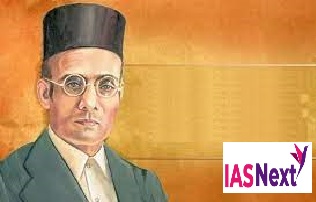CURRENT AFFAIRS
Get the most updated and recent current affair content on Padhaikaro.com
Who is Veer Savarkar?
- IAS NEXT, Lucknow
- 02, Dec 2021

Reference News:
Central Information Commissioner (CIC) Uday Mahurkar recently said the era of V D Savarkar, known as the architect of Hindutva ideology, has already set in India and that his personality is above Bharat Ratna, the highest civilian honour.
What’s the issue?
A quote attributed to Savarkar has been going around in academic circles which shows that Savarkar supported Jinnah’s two nation theory.
- However experts are of the opinion that while Jinnah wanted partition, Savarkar wanted Territorial Integrity of India.
- Jinnah wanted minority representation while Savarkar wanted Majority rule.
- Jinnah wanted residuary powers to reside in the provinces but Savarkar wanted them to reside in Centre.
- Jinnah wanted reservation in recruitment to civil/public service while Savarkar wanted merit to be the sole criterion.
Who is Veer Savarkar?
Born on May 28, 1883 in Bhagur, a city in Maharashtra’s Nashik.
Nationalism and social reforms:
- Formed a youth organization- Mitra Mela, this organization was put into place to bring in national and revolutionary ideas.
- He was against foreign goods and propagated the idea of Swadeshi.
- He championed atheism and rationality and also disapproved orthodox Hindu belief. In fact, he even dismissed cow worship as superstitious.
- He also Worked on abolishment of untouchability in Ratnagiri. Dr Babasaheb Ambedkar also compared his work to Lord Buddha.
- Vinayak Savarkar was a president of Hindu Mahasabha from 1937 to 1943.
- When congress ministries offered resignation on 22nd oct 1939, Hindu mahaasabha under his leadership cooperated with Muslim league to form government in provinces like Sindh, Bengal and NWFP.
- In Pune, Savarkar founded the “Abhinav Bharat Society”.
- He joined Tilak’s Swaraj Party.
- He founded the Free India Society. The Society celebrated important dates on the Indian calendar including festivals, freedom movement landmarks, and was dedicated to furthering discussion about Indian freedom.
- He believed and advocated the use of arms to free India from the British and created a network of Indians in England, equipped with weapons.
Important works:
- Book- The History of the war of Indian Independence.
- An armed revolt against the Morley-Minto reform.
- Two-nation theory in his book ‘Hindutva’.